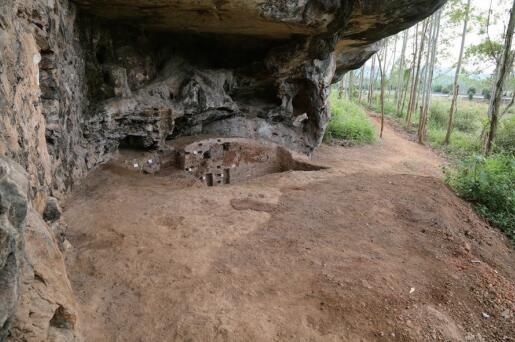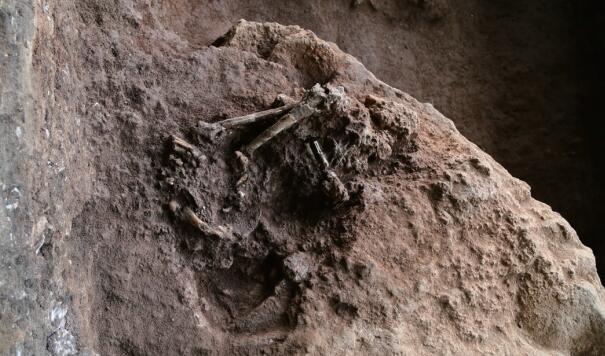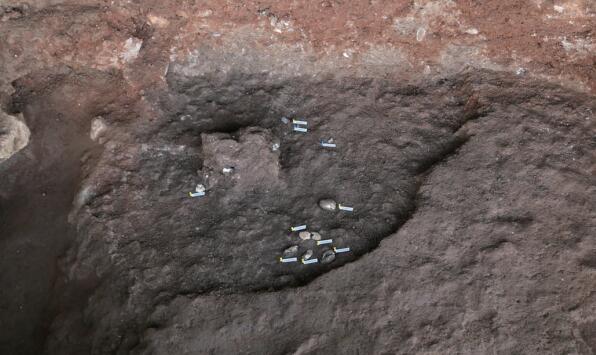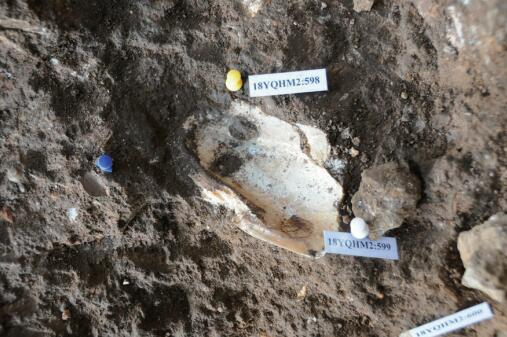The earliest squatting burial in South China found at Qingtang site, Guangdong
The site of Qingtang is located in the town of Qingtang, Yingde city in Guangdong province. This typical cave site dating back to the Upper Paleolithic in Lingnan area comprises seven localities, including No.1-4 cave at Huangmenyan, Zhuwuyan, Diaozhuyan and Xianfoyan. A research excavation on Qingtang site was conducted by the collaboration between the Guangdong Provincial Institute of Cultural Relics and Archaeology and the College of Archaeology and Museology at Peking University in 2016-2018.

No.1 cave at Huangmenyan
Archaeological Findings
The excavation area has reached to 54 square meters. It revealed continuous strata from the Upper Pleistocene to the Lower Holocene, key features including burials and hearths, and more than ten thousands artifacts of great variety including human fossils, chipped stone tools, perforated stone tools, partially polished stone tools, pottery, mussel shells, animal bones, antlers and mammal fossils.
A burial was found in the No.1 cave at Huangmenyan. A complete set of human skeleton was recovered in the position of squatting (Semi-flexed burial in squatting position). The coexisting carbon samples yielded an AMS dating range between 13,600-13,455 cal. yrs BP (calibrated), which made it the earliest burial with recognized burial position in South China as well as the most complete set of human fossils before 10,000 BP found in Guangdong.

Squatting burial
The earliest perforated mussel shells dated to 20,000 yrs BP were found in the No.2 cave at Huangmenyan. In addition, the early pottery sherd dating to 17,000 yrs BP found in Qingtang site illustrated the local settlement transformation from the Paleolithic to the Neolithic. These evidences suggested that modern human chose caves as their dwellings based on the consideration of climate and environmental conditions. Settlements were also patterned in each phase. Synchronous localities may suggest their functional differences. Spatial compartmentalization at the scale of locality also appeared, as suggested by the No.2 cave at Huangmenyan.

Hearth remain
Preliminary study suggested four developmental phases at Qingtang site. The excavation not only established a stratigraphic and cultural sequence from 25,000 to 10,000 yrs BP, but also revealed a detailed process of paleoclimate change from the MIS 2 (29 kyrs, Late Glacial Maximum) to the Lower Holocene and its correspondence to the prehistoric cultural development during this period , which was characterized by the transition from hunting-gathering to early farming. What’s more, the archaeological findings such as the earliest recognized burial, the earliest perforated shell tool in south China and the early pottery sherd dating to 17,000 yrs BP were all provided excellent source of information from this period.

Perforated shell tool
Academic Significance
By means of continuous cultural strata and the process of cultural development, the excavation at Qingtang site provided important data for environmental archaeology to study the man-land dynamics since the Upper Pleistocene. The discovery of early burials facilitated discussions on the social development in the Paleolithic, the emergence of religion and the evolution of modern human. While the discovery of early pottery widely used in South China between 20,000 and 10,000 yrs BP is critical for archaeologists to explore multiple topics such as the origin and dispersal of modern human, prehistoric cultural exchange between East Asia and Southeast Asia, and the transition from the Paleolithic to the Neolithic etc. (Translator: Wen Chenghao)

